Fallen Flags of Garden Railroading - Delton Locomotive Works
While LGB's trains still dominated garden railroading, there was a continual expressed desire from American model railroaders for realistic US-style trains. Kalamazoo's attempts to fulfill that need were not 100% successful because some folks didn't like their "foreshortened" locomotives. The Delton Locomotive works was a labor of love, an attempt to build realistic and solid models of American prototype trains. Though ultimately the company did not survive, it had more influence on Large Scale train manufacturing than any of the other fallen flags, except AristoCraft (which comes later).
Note: David Fletcher's article The Phil Jensen Story follows the career of one of a model train designer who designed several of Delton's most memorable products. I am indebted to this article for some of the details in the following text.
In 1983, Bob Schuster started Delton Locomotive Works to focus on building more realistic models. Bob settled on 1:24 scale, which was a common dollhouse and modeling scale in those days. This made Delton's trains a little smaller than similar LGB trains, which were 1:22.5, but early adopters were very glad to get models that looked like they belonged in North America instead of Bavaria.
 Delton produced a number of limited-edition all-brass locomotives that were true scale models (if maybe a bit smaller than they should have been to be models of 3'-gauge locomotives on 1.775"- gauge track). These included a 2-6-6T Mason Bogie (shown right), a 4-2-4 "C. P. Huntington," 0-6-0s, 0-4-0s, and 2-6-0s. Because they were hand-assembled from start to finish, they were far too expensive for the average garden railroader, though. Delton produced a number of limited-edition all-brass locomotives that were true scale models (if maybe a bit smaller than they should have been to be models of 3'-gauge locomotives on 1.775"- gauge track). These included a 2-6-6T Mason Bogie (shown right), a 4-2-4 "C. P. Huntington," 0-6-0s, 0-4-0s, and 2-6-0s. Because they were hand-assembled from start to finish, they were far too expensive for the average garden railroader, though.
 Designer Phil Jensen came on to design a line of plastic 1:24 freight cars for the trains to pull. Phil developed several, including the intricate and charmining outside-frame wooden hopper shown to the right. Designer Phil Jensen came on to design a line of plastic 1:24 freight cars for the trains to pull. Phil developed several, including the intricate and charmining outside-frame wooden hopper shown to the right.
Phil later confessed that he made mistakes because he was new at the model-train designing business. His cars had almost no parts that could be used in other models; every new car he designed required almost 100% new tooling. As far as I know, no one at the time thought - or realized - that it was a problem. But Phil later confessed that if he "knew then what he knows now" and had designed those early products with an eye to making as much of the tooling as reusable as possible.
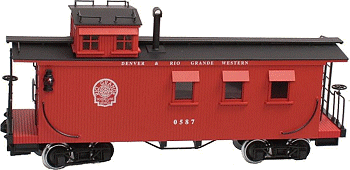 Another Jensen-designed car that was a favorite of Delton fans was the long caboose, sometimes called a "Drovers' caboose." That's because in the old days of cattle drives, some of the cowboys would ride along when their cattle were being shipped to help them get where they were supposed to at the other end of the line. Since the cowboys typically hadn't bathed for months and didn't want to pay to sit in the passenger cars at any rate, "drovers' cabooses had extra seating and sometimes bunks to accommodate them. Other companies have made Large Scale drovers' cabooses since, but this one had a profile that is still recognizable today. Another Jensen-designed car that was a favorite of Delton fans was the long caboose, sometimes called a "Drovers' caboose." That's because in the old days of cattle drives, some of the cowboys would ride along when their cattle were being shipped to help them get where they were supposed to at the other end of the line. Since the cowboys typically hadn't bathed for months and didn't want to pay to sit in the passenger cars at any rate, "drovers' cabooses had extra seating and sometimes bunks to accommodate them. Other companies have made Large Scale drovers' cabooses since, but this one had a profile that is still recognizable today.
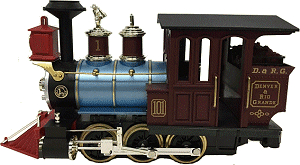 Collaboration with Lionel Collaboration with Lionel
In 1987, Lionel toyed with the idea of getting into garden trains (toy being the operative word). According to Fletcher's article, they considered buying Delton outright but determined that they would be assuming too much debt. Instead they contracted with Delton to produce the designs and tooling for their first Large Scale train set, the Gold Rush Special.
The 0-6-0T that pulled it was based in part on the design of the Mason Bogie that Delton had produced earlier, with length in the boiler and windows in the cab reduced to cut down on size. The result was a very charming little locomotive that also ran very well (even if it did borrow some of its gearing from Lionel's tinplate engineering). Unfortunately, the side gear and many of the details were far too fragile for handling by children. That said, I have owned several in different paint jobs, and consider it the "flagship" of Lionel's track-powered G-gauge trains (their subsequent offerings notwithstanding).
The Delton Consolidation
While Phil and Bob were trying to decide which steam locomotive to introduce in plastic, LGB came out with their 1:22.5 Mogul, so the Delton team dropped their own plans to build a Mogul and decided to model possibly the most popular Narrow Gauge engine ever designed - the Consolidation that D&RG called the C-16.

The locomotive came out in 1989. It was an attractive, affordable, and solid little locomotive, that, in spite of its smaller scale looked fine near much of the other garden trains being built at the time. Some folks felt it was a little underpowered, but it looked and ran great IMHO.
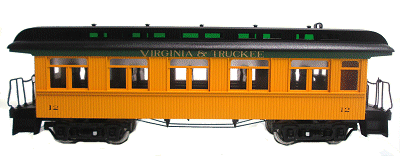 Phil also designed two lines of coaches. I own the "long" coach shown to the right, and it is a dandy and solid little model. Phil also designed two lines of coaches. I own the "long" coach shown to the right, and it is a dandy and solid little model.
The other line is a "shorty" line. You can see the outline of the "combine" car from that line in the "Delton Doozie" photo below.
The Delton Doozie
When Delton ran into difficulty coming up with money to develop new products, they looked for ways to reuse what they had. One of their 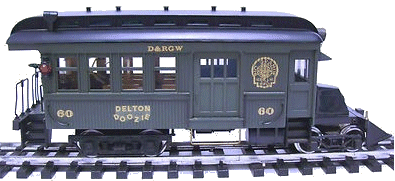 most profitable models was the "Delton Doozie," a little "railbus" made by putting a Mack Truck front end onto a shorty coach. most profitable models was the "Delton Doozie," a little "railbus" made by putting a Mack Truck front end onto a shorty coach.
Railbusses have a long and stored history that goes back to the early 1900s. Countless railroads trying to service small towns and spurs that didn't justify running steam locomotives either ordered railbusses directly from the Mack factory or built their own. The D&RGW railbusses and similar gas-powered rail vehicles such as the "Galloping Geese" are so well known today because D&RGW continued to use them long after most other railroads had abandoned their use or moved on to diesel rail cars.
Delton's railcar was dubbed the "Doozie." When Delton - sadly - was forced by business pressures to shut down, AristoCraft attempted to recreate it with molds they already owned, and Hartland Locomotive Works eventually reissued it with a slightly improved power truck.
To see an original "Doozie" at work, you can check out this YouTube video. If that doesn't work, click here. (The link will take longer to download, because it's higher resolution.)
But in the long term, Delton could not overcome the manufacturing costs that had gone into its flagship products. In 1990, Delton went into bankruptcy. One of their major creditors, Caledonia, attempted to keep the manufacturing lines open. but that manufacturing shut down in 1993.
When Delton went out of business, their molds and engineering were purchased by other companies. A couple of those companies struggled to keep things profitable, and some of the molds changed hands again.
More Kalamazoo
When Delton closed down, Phil Jensen went over to help Kalamazoo upgrade their line, using knowledge he had picked up from his experience at Delton, and even some of the individual brass pieces that one of Delton's suppliers had left over.
Then Kalamazoo closed down. Kalamazoo's molds and Phil himself went to Hartland Locomotive Works (HLW), where Phil continued to enhance the Kalamazoo 4-4-0 and eventually added other products based on the Delton coach molds (see below).
AristoCraft Classic Line
In 1996, AristoCraft purchased Delton's molds except for the coach molds (which Delton didn't technically own). This purchase gave AristoCraft the Consolidation molds and several of the freight car molds.
 AristoCraft made some adjustments to the Consolidation, which - I am told - included raising the cab height. Depending on who you talked to this was either done to accommodate a more powerful motor or to help the locomotive look more visually compatible with products built in other scales (1:24 was becoming less popular). Nobody argues the fact that AristoCraft's reengineered drive mechanism gave the Consolidation substantially more pulling power. For a time, the Consolidation led AristoCraft's "Classic" line. AristoCraft made some adjustments to the Consolidation, which - I am told - included raising the cab height. Depending on who you talked to this was either done to accommodate a more powerful motor or to help the locomotive look more visually compatible with products built in other scales (1:24 was becoming less popular). Nobody argues the fact that AristoCraft's reengineered drive mechanism gave the Consolidation substantially more pulling power. For a time, the Consolidation led AristoCraft's "Classic" line.
By the way, last week I visited a garden railroad that had several of the Aristo-built "Delton Classic" Consolidations running simultaneously on separate right of ways, and they were running very well, and pulling trains of decent length. So if you come across one in excellent condition, don't be afraid of it just because it has the upgraded power train.
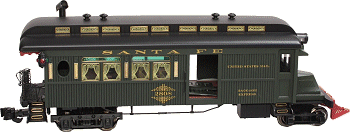 AristoCraft also issued their version of the "Doozie," using the combine car from their Sierra line (since they didn't have the Delto coach molds). Unfortunately, the power truck sat a little high, so the thing sloped a little. But handy crafters who liked the overall look figured out how to fix that. AristoCraft also issued their version of the "Doozie," using the combine car from their Sierra line (since they didn't have the Delto coach molds). Unfortunately, the power truck sat a little high, so the thing sloped a little. But handy crafters who liked the overall look figured out how to fix that.
In truth, the Polks (owners of AristoCraft) never expected to make "real money" from the Delton products; mostly they just didn't have the heart to see such a valuable contribution to the US Garden Railroading hobby disappear. Keeping the Delton line alive was a labor of love that never paid off, but I'm glad they made the effort, because I, frankly, feel the same way.
When (spoiler alert) AristoCraft went out of business, the old Delton molds were still in China. No one really knows where they are now, although some of the tooling for AristoCraft's core products is beginning to show up in Bachmann Large Scale offerings, so there's always hope.
Hartland Locomotive Works
Soon after Phil Jensen went to HLW, HLW acquired the coach molds he had designed for Delton. HLW put them behind the upgraded 4-4-0. Hartland has since has reissued them, not only as passenger cars, but also as doodlebugs and streetcars. In addition, several design protototypes that Phil Jensen had produced for Delton found new life at Hartland, including the double-ended 4-wheeled diesel or diesel-electric locomotives.
A Note for Traction Lovers - If you love trolleys, street cars, rail buses, and the like, you need to check out Hartland's line of self-propelled vehicles. If you love such things and don't think they look right without wires running overhead, that's fine, too. Using Delton's coach molds and other designs and plans left over from Delton, Phil has helped HLW to create whole family of electric or diesel-electric or gas-powered units that meet your needs. Here are a few of my favorites:
When I initially wrote this article, the HLW coaches were not being made, and some of the self-propelled cars based on those molds were coming into short supply. However, Phil assured me that they would become available again.
For a detailed history of Delton and how its designs influenced other manufacturers, check out David Fletcher's article The Phil Jensen Story.
Desirability
Delton's brass locomotives are all highly desirable collectors' items. Their Consolidation is also a favorite among us old timers, but mostly among people who want to run the thing.
When AristoCraft began closing out it's "Classic" line of trains based on Delton molds, they closed them out cheap, but value for like-new unique models like Consolidation, the open-frame hopper, and the long caboose is going back up.
If you want to run them, they are visually compatible with the Lionel track-powered 0-6-0t "Gold Rush" set and most of HLW's trains. Or if you're like me, you just don't put your Bachmann 1:20.3 stuff next to it. Ironically, because it models small prototypes, Delton-designed stuff does not look out of proportion with most 1:32 or 1:29 models of old-timey trains, unless you start counting handrails or some such.
And personally, I still prefer the Delton-inspired traction to anyone else's traction line today. Aren't you glad it's still available, even if under another brand name?
Click here to return to the Fallen Flags of Garden Railroading index page.
| 
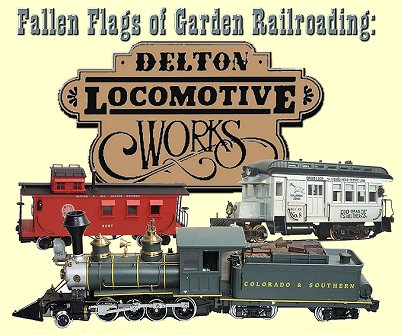














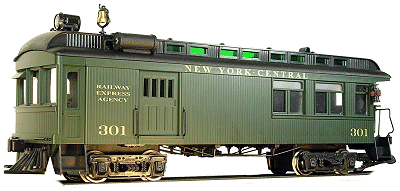
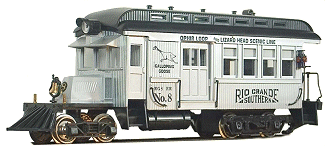
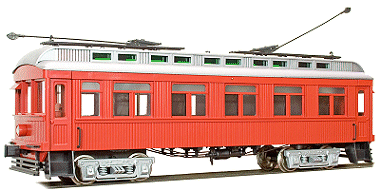

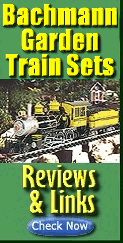












































 Delton produced a number of limited-edition all-brass locomotives that were true scale models (if maybe a bit smaller than they should have been to be models of 3'-gauge locomotives on 1.775"- gauge track). These included a 2-6-6T Mason Bogie (shown right), a 4-2-4 "C. P. Huntington," 0-6-0s, 0-4-0s, and 2-6-0s. Because they were hand-assembled from start to finish, they were far too expensive for the average garden railroader, though.
Delton produced a number of limited-edition all-brass locomotives that were true scale models (if maybe a bit smaller than they should have been to be models of 3'-gauge locomotives on 1.775"- gauge track). These included a 2-6-6T Mason Bogie (shown right), a 4-2-4 "C. P. Huntington," 0-6-0s, 0-4-0s, and 2-6-0s. Because they were hand-assembled from start to finish, they were far too expensive for the average garden railroader, though.
 Designer Phil Jensen came on to design a line of plastic 1:24 freight cars for the trains to pull. Phil developed several, including the intricate and charmining outside-frame wooden hopper shown to the right.
Designer Phil Jensen came on to design a line of plastic 1:24 freight cars for the trains to pull. Phil developed several, including the intricate and charmining outside-frame wooden hopper shown to the right.




 most profitable models was the "Delton Doozie," a little "railbus" made by putting a Mack Truck front end onto a shorty coach.
most profitable models was the "Delton Doozie," a little "railbus" made by putting a Mack Truck front end onto a shorty coach.

